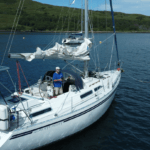
Crew of dismasted yacht in Irish Sea saved by locator beacons

The captain of a yacht whose mast collapsed during the night have told of his dramatic rescue in the Irish Sea earlier this month, using his and the crew’s experience to remind boaters that safety equipment saves lives.
Skipper Mike Hallgarth (67) had been sailing his 37-foot vessel Glad Eye Moody with two crew across the Irish Sea from Bangor to Portishead. He was heading home on the last leg of a voyage up the east coast of the UK that had started in May.
Disaster struck late on 17 August when the mast came away, leaving the yacht powerless in the dark on choppy waters.
Hallgarth, who has a decade of sailing experience, said “there was no warning” when the mast went down.
Using the engine ran the risk of fouling the propeller on the wreckage hanging over the port side, but with debris flailing around, it was too dangerous to go on deck to cut the rigging away.
The radio appeared not to work, due to the aerial being underwater, but a Pan Pan broadcast for help was sent “in the blind” – not knowing whether it had been received.
The call was picked up by a nearby freighter who approached and, via handheld radio, could relay messages to HM Coastguard’s Belfast Maritime Rescue Coordination Centre (MRCC).
Hallgarth says: “It was a bad situation but all three on board held RYA Day Skipper qualifications, so were confident of the safety procedures and there was no panic.”
Crucially, the yacht was carrying an emergency position indicating radio beacon (EPIRB) and the crew had a personal location beacon (PLB) on board.
When the EPIRB was triggered, it alerted Belfast MRCC to Hallgarth’s position midway between the Isle of Man and Strangford Lough on the east coast of Northern Ireland. That was followed up by the PLB, adding another signal to guide rescuers through the darkness towards their location.
“I would say the EPIRB and PLB were a key feature, and the only hope given the apparently not working radio,” says Hallgarth. “They send out the distress signal and give the exact position of the device.
“For the sake of a few hundred quid, I would recommend everyone to get at least one. It’s essential and must be up to date and with its batteries tested.”
He adds: “Now it’s all finished, I am more conscious of the severity of the situation.”

Ocean Signal EPIRB PLBs are an example of a beacon that can pinpoint a location to potential rescuers.
The RNLI‘s all-weather lifeboats from Peel, on the Isle of Man, and Donaghadee were sent, supported by the HM Coastguard helicopter from Caernarfon and an Irish Coast Guard helicopter.
Peel lifeboat was able to find the vessel and safely bring Hallgarth and his two crew back to Peel harbour – just seven hours after the alarm was raised.
Beacons are an inexpensive and effective safety tool for accidents at sea, able to pinpoint an exact location to rescuers.
Earlier this year, seasoned catamaran competitors Theodore Gijsbers and Maud Van Toorenburg shared their harrowing experience during an open catamaran competition on the Haringvliet in 2023. In the process, they gained the dubious honour of becoming the first documented rescue using Ocean Signal’s rescueME PLB3 beacon.
In 2023, a solo sailor onboard a critically damaged yacht, around 600 nautical miles out at sea, was saved as part of a two-day rescue operation led by HM Coastguard. An initial beacon alert was received by HM Coastguard after the sailor activated the beacon while in the Atlantic Ocean, west of Cornwall.
And Portuguese drone manufacturer Tekever is taking this one further, by deploying lifeboats from unmanned aircraft. The drones can detect vessels or humans on the water, using optical and infrared cameras, a maritime radar, an AIS receiver and an emergency position-indicating radio beacon antenna.
The drone’s AI then calculates the optimal time to release the lifeboat close to the vessel or person in distress without human intervention, enabling the lifeboat to be deployed at a close enough, but safe, distance.
The aim is to improve maritime safety and reduce the 2,500 marine casualties and incidents EU member states report annually (EMSA, October 2023).
The post Crew of dismasted yacht in Irish Sea saved by locator beacons appeared first on Marine Industry News.
